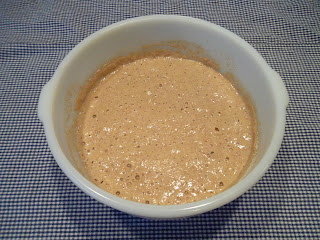 |
| Smoked Gouda, Gouda, and Limberger cheeses |
A little over half of the milk produced in the Netherlands is processed into cheese, about half of which consists of various varieties of Gouda. Dutch cheeses are exported to 130 countries, with Germany, Belgium, France, and the United Kingdom importing the largest quantities.
I recall visiting a cheese store in Zaanse Schans when I was in the Netherlands last summer, where you could sample a great variety of different kinds and flavors of cheese. It was almost as good as visiting a chocolate factory.
My favorite kind is indeed Gouda, which is mild, smooth, and creamy. I used it to make a comfort food for a damp and dreary day: good old macaroni and cheese. The recipe in Grandma VandenBergh's old cookbook was a little different from the way I usually make it, as it did not include added milk. But whether you make macaroni and cheese from a box (which I don't recommend), or from your favorite recipe, it can cheer you up on a gray winter day. In true frugal Dutch fashion, the recipe also suggests a way to use up some leftover ham, and suggests using "old, dried chunks" of cheese.
Macaroni with Ham and Cheese
- 100 grams (1/2 to 1 cup) ham
- 200 grams (2 cups) macaroni
- 1/2 liter (2 cups) water
- 1/2 teaspoon salt ("wat zout")
- 100 grams cheese (4 oz.; about 1 cup grated)
- 30 grams (2 tablespoons) butter
- breadcrumbs for sprinkling on top
-Cook the macaroni according to the directions on the package. While it is cooking, chop or cube the ham, and finely grate the cheese.
- When the macaroni is almost cooked and most of the water has evaporated, add the ham and cheese and toss.
- Add half of the butter, pour the mixture into an ovenproof baking dish, sprinkle with breadcrumbs, dot with the remaining butter and set in a medium oven until crusty.
The recipe is the simplest I've ever seen for made-from-scratch macaroni and cheese. It is a bit drier than I am accustomed to, so I did add about 1/3 cup milk while mixing it up, to make it a bit creamier.
 |
| Mac and cheese with ham |
A Dutch cow produces about twenty liters of milk per day; it takes ten of those liters to produce one kilo of Gouda cheese. So the next time you enjoy a slice of Gouda, think of the cow that produced enough milk to make two kilos of your favorite cheese, a cheese which has been sold on the Gouda cheese market for over three hundred years.
* * *
Sources:
Dutch Dairy Industry. Nederlandse Zuivel Organisatie (Dutch Dairy Board) http://www.nzo.nl/images/html/DutchDairyIndustryAV100924.pdf Accessed 1/28/2012.
Engelbrecht, Karin. "Say Cheese! Dutch Cheese - Dutch Cheese Varieties" http://dutchfood.about.com/od/aboutdutchcooking/a/SayCheese.htm Accessed 1/28/2012.
"From Cow to Cheese - Cheese in the Netherlands" http://www.kaasmarkt.nl Accessed 1/28/2012.











